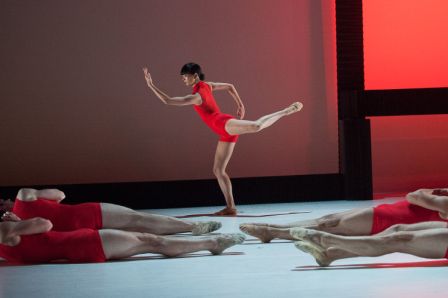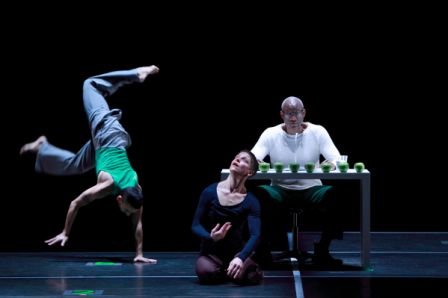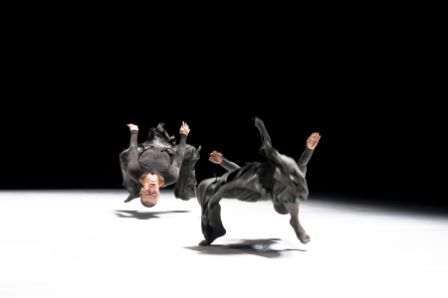foot in mouth: August 2012 Archives
The free outdoor shows peppering New York and and the outer boroughs each summer always have their separate agendas but this year a stark divide emerged. On one side was the community-building event, in neighbourhood parks from the South Bronx to central Brooklyn to the banks of the East River. The art mattered insofar as it drew spectators together and lifted them up. On the other side was site-specific experimental dance aimed to shock the bourgeoisie or at least the workers on their lunch breaks and tourists. It may be possible both to flout convention and to empower, but it did not happen on my watch.St Mary's Park is a 10-block-long, five-avenue-wide, tree-shaded oasis just beyond a grimy strip of the South Bronx that the City's sanitation department has apparently neglected for decades. At the northwest corner of the park, picnics, birthday parties, barbecues and children were everywhere, the kids dashing in and out of a makeshift fountain, lining the basketball courts to watch the pick-up games, and dancing to their gathering's particular soundtrack - salsa, reggaeton or soul.Up the hill and insulated from the cacophony, Ana "Rokafella" García, co-founder of the excellent Full Circle hip-hop troupe, was expertly hosting a Bronx-inflected street, folk and club dance extravaganza for the City Park Foundation's Summerstage. She kept things tight. Whether the dancers specialised in Afro-Caribbean, salsa, vogue, brukup or forms of hip-hop, segments were limited to 15 minutes. Afterwards, each troupe had a chance to describe its idiom and how we might learn the moves. Websites and practice days were shouted out.The organisers and dancers wanted the crowd to "aspire" - to Keep Rising to the Top, as one spunky youthful East Harlem group called itself. But when the performers included Brooklyn brukuppers capable of insane feats of double-jointedness and a salsa dancer in knee-high boots undulating her hips and swivelling her feet faster than a Dancing with the Stars pro, emulation seemed out of the question.The last act offered a less outlandish vision of hope. All the evening's dancers joined in a freestyle circle - a phenomenon the South Bronx invented- and took turns in the centre to pop, lock, primp, lope, spin on their heads, and more. The dancers were co-operative and individualistic - enthusiastic about one another and proud of their own signature moves. These last moments held out a beautiful promise: there will be room for each of us, in our idiosyncrasies, as long as there is room for all of us.Manhattan's River to River festival tends to favour, by contrast, a spiky approach to the audience. Even those who showed up expressly for the event - and River to River's focus on work embedded in the urban landscape encourages the opposite, an accidental audience - were unprepared for the startling opening of Uruguayan émigré Luciana Achugar's FEELingpleasuresatisfaction-celebrationholyFORM.From the far end of a covered arcade in Tribeca, four Cousin Itt mop-heads above bare womanly legs strode toward us shoulder to shoulder. Once near, the faceless women manoeuvred their jeans up to their hips without the use of their hands: they wiggled and kicked. They flopped on the concrete like beached sea lions and pressed themselves against the glass façade of the new Conrad Hotel opposite us.Feel ... Form was outrageous and funny, but the humour was edged with cruelty.

Jacob's Pillow has long been an outpost of forward thinking. Before the idea of "cultural diversity" existed, founder Ted Shawn was inviting Indian classical dancer Ram Gopal and pioneering black ballerina Janet Collins to join his mixed repertory concerts at this remote idyll in the Berkshires, an hour from Albany and two from Boston. In an onsite exhibition to celebrate the Festival's 80th anniversary, a 1954 photograph shows Gopal sailing into a Technicolor-blue sky, no stage in sight. On another wall, Collins in 1949 - after the Ballets Russes de Monte Carlo had rejected her for her skin colour but before the Metropolitan Opera took her on - stretches out sideways in modernist angst.
From the preserved barn theatres to the invaluable archives, the Pillow testifies to dance's rich and varied history. The vision it provides of the future is less bright, however. Not even the storm last weekend, which turned the gravel walkways into shallow ponds and emptied the lawns of the customary picnickers, scared people off the shows. But the full houses were mainly made up of the retirement set.
No matter. The two shows were worth intimations of mortality--for dance, I mean. I caught the debut of Jessica Lang's eponymous troupe:
Lang, a rare woman in big league ballet-making, is prolific but as she is a freelancer (for American Ballet Theatre, Birmingham Royal Ballet and so on) you may not have heard of her....
In the generous programme of dances from the past seven years, the steps and their spatial arrangement were strong and bright, like the Mondrian that inspired the premiere Lines Cubed.

recurrent fascination with how feeling and spirit radiate out from a person. But she has not pushed the idea far enough to unite lush humanism with geometric clarity. A troupe of her own, with these eloquent dancers, may free her for that pursuit.
Eventually a theme emerges from the scatter of tales. Jones's mother grieving over her husband by rolling across the floor like "a child on a grassy hillside"; the beauty of snow piling on winter branches; the trip Jones took to the Theresienstadt concentration camp with his mother, who, confusing it with a cemetery, said she had heard the best place to learn guitar was a graveyard at night, evoke time passing relentlessly, poignantly.
As tool more than theme, time also distinguishes the choreography--the most intricate and mesmerising I've seen from Jones.

From my Financial Times review of the Tao Dance Theatre, at Lincoln Center Festival last week--one of the few modern dance companies from mainland China, and extraordinary:
China came late to modern dance - and nothing is as deadly as a recent convert's earnest faith. So when the programme declared that Beijing choreographer Ye Tao, of the five-year-old Tao Dance Theater, "eschews representational modes of dance" even to the point of forgoing words for numerals in dance titles, I thought I knew the kind of discovery we were in for: all on their end, none on ours. What a relief to be wrong.
The 90-minute show was not easy. The impersonality of its outrageousness may have precluded hot-headed protest, but by the halfway mark of the second piece the entire row behind me had tiptoed out.
This duet, entitled 2, began with Tao and co-choreographer Ni Duan lying on their bellies for five minutes like green mould against the bright white floor while folk-punk composer He Xiao engulfed us in high-pitched static. The piece ended strangely too, with the eccentric music carrying on after the dance had finished and the dancers had re-entered to wait for it to croak its last so they could bow.
It was the first time they stood. Until then the duo had flopped about on their bellies and backs and sidled samurai-style from knee to knee in swampy, swirly, unexpectedly gorgeous patterns. But more than the low-riding style, the long freezes or the industrial detritus that Xiao mixed with fairy tinkles and swathes of chalky cello, it was 2's flouting of structure that proved bracing - or, for some, unbearable. The duet was all about starting and stopping and starting again without ever quite becoming.
Ye Tao and Ni Duan riding low in 2. Photo by Matthew G. Johnson courtesy of the Lincoln Center Festival.
I admired the squirm-inducing 2, but 4 really made me want to keep up with the young choreographer's work.
For what distinguished 4 from 2, please click. Every click is a click for dance (and you only have to free-register once for perpetuity).
AJ Blogs
AJBlogCentral | rssculture
Terry Teachout on the arts in New York City
Andrew Taylor on the business of arts & culture
rock culture approximately
Laura Collins-Hughes on arts, culture and coverage
Richard Kessler on arts education
Douglas McLennan's blog
Dalouge Smith advocates for the Arts
Art from the American Outback
Chloe Veltman on how culture will save the world
For immediate release: the arts are marketable
No genre is the new genre
David Jays on theatre and dance
Paul Levy measures the Angles
Judith H. Dobrzynski on Culture
John Rockwell on the arts
innovations and impediments in not-for-profit arts
Jan Herman - arts, media & culture with 'tude
dance
Apollinaire Scherr talks about dance
Tobi Tobias on dance et al...
jazz
Howard Mandel's freelance Urban Improvisation
Focus on New Orleans. Jazz and Other Sounds
Doug Ramsey on Jazz and other matters...
media
Jeff Weinstein's Cultural Mixology
Martha Bayles on Film...
classical music
Fresh ideas on building arts communities
Greg Sandow performs a book-in-progress
Harvey Sachs on music, and various digressions
Bruce Brubaker on all things Piano
Kyle Gann on music after the fact
Greg Sandow on the future of Classical Music
Norman Lebrecht on Shifting Sound Worlds
Joe Horowitz on music
publishing
Jerome Weeks on Books
Scott McLemee on books, ideas & trash-culture ephemera
theatre
Wendy Rosenfield: covering drama, onstage and off
visual
Public Art, Public Space
Regina Hackett takes her Art To Go
John Perreault's art diary
Lee Rosenbaum's Cultural Commentary


Recent Comments